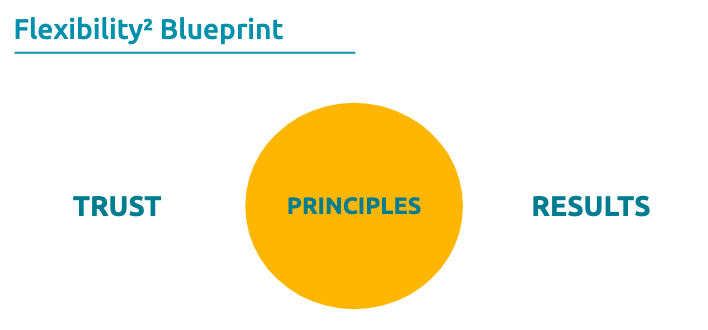How Can We Enable Diverse Teams To Leverage Flexibility?
Sep 23, 2019
Creating working environments where diversity in teams can thrive requires flexibility and there’s no one size fits all solution.
We need to provide flexibility whether it is for someone celebrating Ramadan and needing to be home at sunset, someone going out on maternity leave, or someone dealing with a sick relative or even a pet.
Everyone is unique, with unique needs and obligations. Inclusive Leaders create environments where people of all backgrounds feel respected, can contribute their talent and perspectives, and are given fair access to meaningful opportunities.
What is the shift needed to enable diverse teams to leverage flexibility?
There is an important inclusive leadership competency required to make this shift - curiosity. It helps teams to think, reason and understand the complexity that comes with flexible working.
“Curiosity is a desire to understand how others view and experience the world, and to practice a tolerance for ambiguity.”
Studies also show that curiosity boosts empathy - another critical skill for collaboration. Here’s the thing about curiosity - it can feel really hard to practice when we are feeling time starved and under pressure to perform.
So here are some things you can start getting curious about...
The first thing you can get curious about is to understand your own approach to work life balance. For people managers, this can often affect how extensively flexibility will be used in the team.
So what is your approach?
- Are you someone who continually blends work and nonwork activities during the day?
- Are you the type of person who prefers to keep work and nonwork activities compartmentalized?
- Or some one who will integrate the work and nonwork aspects of your life at times and then separate them at other times?
How might your own flex-style be influencing your perspective about flexing in your team?
And if you have a sense of how you like to manage your work and non work commitments - think about this question - how might it be influencing your perspective about flexing in your team?
The second thing to get curious about is how heavily dependant you are on “line of sight” as a basis for managing or teaming with people; the approach that many managers and colleagues use to evaluate people and to deal with everyday activities.
Your dependence on line of sight management, watching people work as a requirement to get work done, and on relating hours at the office with performance, may be placing unnecessary hurdles to the successful implementation of flexible schedules.
Just as with our flexibility preferences - think about how this might be influencing how willing you feel have a conversation with the client about it. Especially a client who is dependent on line of sight management. This is especially true in the service industries such as banking and consulting.
How can teams make this easy?
From our own research and working with leading employers, we have designed the Flexibility² Blueprint for you to evaluate requests and design a flex-work structure that works for you, the employee and the team.
We go through this in full during our manager and leadership training workshops, but here’s a brief overview. We break this down into Principles.

Principle #1: Trust
The first principle is trust, and it is a two-way street. Managers need to trust their employees, and employees need to trust their managers.
The traditional line of sight management operates on the principle that people will not work unless they are been checked upon, and managers do not trust employees to work without them looking over the shoulder.
For the employees it has translated into worrying that if they are not in the office and not ‘seen’ working, they might be considered as not being committed to the organization and their jobs, they don’t trust that their managers will recognize their efforts.
When trust is present an important change takes place - it takes away the suspicion. Managers will assume that if an employee says they are working, they are!
Employees will trust and believe their manager when they say that their evaluation will not be negatively affected because of the use of flexible schedules.
Principle #2: Results
This principle directly relates to breaking from the assumption that time equals commitment and performance, and instead shifts the focus towards the tangible results of work as a measure of performance.
Successful flexible work arrangements focus on the work and the results of the work, not on the hours worked. This assumption makes it dramatically easier to have flexible schedules.
Working in an organization where this principle is present results in increased responsibility over the employees using the flexible schedules. Employees must realize that what they do impacts other members of the team and that they need to get their work done as expected, and when that is not possible they need to communicate with the team.
From our research, these two principles - trust and tangible work results - seem to be the foundation that makes the flexible work arrangements work. Without them the road to flexibility would be riddled with suspicious, negative consequences, and lack of respect.

Practice #1: Planning
Planning practices attempt to affect the way managers and employees plan their work. These are aimed at helping you plan for the flexibility needs of your team, assess whether work is getting done, and to identify potential problems.
Planning the execution of a project or your day-to-day operations and work-streams can help facilitate flexibility; it allows you to establish a plan to measure against, and your team members to know their responsibilities and dependencies. It also helps the employee to show that work is being done and to plan for the future needs of the project.
It is important that you include the team in the planning process, this will help both sides to understand the flexibility needs and how they relate to the planning. This will also provide an opportunity for the employees to understand the higher level of responsibility they assume when working with flexible schedules.
If the work is divided smartly, deliverables are clearly defined, individual needs taken into account, and clear rules established, then the project is likely to succeed.
A key learning for managers who have adopted this approach is that different phases of the project have different needs, and that people have different flexibility needs.
Practice #2: Execution
These practices aim to create and facilitate interactions between the different members of the team and the manager. If people have varying schedules, being able to coordinate activities so dependencies and interactions do not suffer is important.
These practices will help reduce your anxiety on how the interdependencies will be handled, and co-workers’ worries about the availability of other team members.
Core hours are useful as they provide time when one could contact other members of the team or easily set meetings. However core hours can be limiting for flexibility by forcing everyone to be present at specific times, especially if the core hours cover a significant portion of the day.
Some of our clients have implemented more flexible incarnations of the typical core hours. They do not require the team to be at the office during these hours but simply to be available. Some groups used mobile phones, email, and/or instant messaging but the rule was whatever method you chose, you had to be reachable during core hours.
Some of our clients have come up with other innovative approaches. For example in one company, more than half of the team members are telecommuters who almost never make it to the office and meetings are not practical for them, so they implemented a shared status report. At the beginning of the week, everyone reports what was accomplished the previous week and what they expect to work on the current week. This report is circulated among the group and helps everyone be aware of the project progress.
Another client has implemented a rule that no meetings should be scheduled on a Friday, so that the whole team can choose where they work that day, be it from home or the office. Either way, the feedback is that everyone achieves a great deal more work on this day due to the lack of interruptions and time away in meetings!
Here’s a summary of what you need to remember:
Best Practices For Leaders:
- Set and review performance goals regularly
- Set mutual clear and realistic expectations
- Set the non-negotiable schedule principles
- Set your core hours
- Consider each employee’s proposal
- Consider the group of proposals together
- Implement, and measure progress during a trial period
Best Practices For The Team:
- Prepare a proposal - your challenges, needs and proposed solutions
- Communicate - where and when you are working
- It should not mean more work for everyone else
If you would like to explore the ways in which you can improve flexibility to support your teams, please email us at [email protected].
Stay connected with news and updates!
Join our mailing list to receive the latest news and updates from our team.
Don't worry, your information will not be shared.
